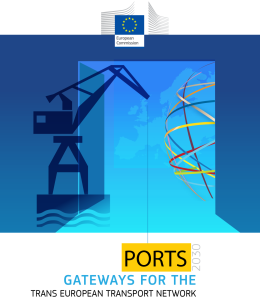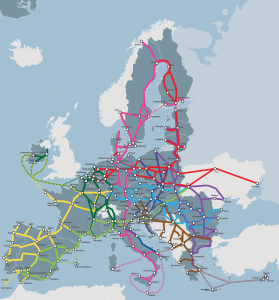European ports are integral to the continent’s transport infrastructure, serving as key nodes that connect maritime routes with rail, road, and inland waterways. As the European Union (EU) faces economic challenges, these ports are seen as critical to boosting competitiveness both domestically and internationally. To maintain and enhance their effectiveness, it is essential to invest in their infrastructure and ensure they are well-integrated into the broader trans-European transport network.

Challenges Facing European Ports
Structural Performance Gaps:
The performance of European ports varies widely. Some are among the most efficient in the world, while others struggle with outdated infrastructure and inefficiencies. This disparity limits the ability of EU ports to function as a cohesive network, with the underperformance of some ports impacting the overall efficiency of the network. A significant issue is that 20% of goods entering Europe by sea pass through just three ports, leading to congestion in those areas and limiting the options available to shippers.
Need for Adaptation:
The port sector must continuously evolve to keep pace with changes such as the increasing size of ships, the need for environmental compliance, and new logistics requirements. For instance, larger container ships necessitate deeper berths and more extensive port facilities. The environmental impact of ports is under increasing scrutiny, with new regulations requiring ports to adopt greener technologies, such as LNG refueling points and cold ironing facilities.
A European Challenge:
European ports serve a hinterland that extends beyond local and national borders, making them crucial to the entire EU’s transport network. The absence of a level playing field across EU ports exacerbates the performance gap, and there is a need for a unified approach to governance and investment.

Core Ports in the Trans-European Transport Network (TEN-T)
Strategic Actions
Connecting Ports to the Trans-European Network:
The TEN-T guidelines and the Connecting Europe Facility (CEF) offer new opportunities for integrated infrastructure planning and targeted investments. These initiatives will ensure that ports are well-connected to the broader transport network, including rail, road, and inland waterways.
Specific projects will be prioritized based on their contribution to the development of core network corridors, which are expected to be operational by 2030.
Modernizing Port Services:
Enhancing the efficiency of port services is crucial for reducing logistics costs and improving overall port performance. The brochure highlights the need for transparent and competitive port service markets, where monopolies are avoided, and services are provided on a non-discriminatory basis.
Administrative simplifications, such as reducing red tape for intra-EU short sea shipping, are also necessary to make ports more attractive and competitive.
Attracting Investment to Ports:
To attract both public and private investments, the European Commission emphasizes the need for a transparent and clearly defined regulatory framework. This includes clarifying state aid rules and ensuring transparency in public funding for ports.
The introduction of more efficient port infrastructure charges, where port authorities have greater autonomy in setting fees based on their commercial strategies, is also proposed.
Promoting Social Dialogue:
Ports are major employers in the EU, with over 3 million people directly or indirectly employed in the sector. The brochure underscores the importance of good working conditions and the need for ongoing dialogue between employers and employees to address labor issues and improve the social climate within ports.
The establishment of a Social Dialogue Committee for the port sector is seen as a positive step toward addressing labor issues at a Union level, with a review of its progress planned for 2016.
Raising the Environmental Profile of Ports:
Ports are significant sources of emissions, noise, and pollution, particularly those located near densely populated urban areas. The brochure calls for ports to balance their operational needs with environmental protection and urban quality of life.
The European Commission encourages ports to adopt best practices in environmental management and to reward operators who exceed mandatory environmental standards.
Encouraging Innovation:
Technological innovation is key to maintaining the competitiveness of European ports. The brochure stresses the importance of research and development, particularly in areas such as logistics management, environmental protection, and worker safety.
The Horizon 2020 program is highlighted as a potential source of support for innovative projects in the port sector.
To conclude, the European ports are positioned at a critical juncture, where their performance can significantly impact the EU’s economic recovery and long-term competitiveness. While some ports are performing well, others face challenges that must be addressed to ensure they can contribute effectively to the trans-European transport network. The European Commission outlines a comprehensive strategy to improve connectivity, modernize services, attract investment, and promote social and environmental sustainability within the port sector.
The successful implementation of these strategies will require cooperation across multiple levels, including EU institutions, member states, and port authorities, as well as the private sector. The ultimate goal is to create a sustainable and efficient transport system that supports the long-term prosperity of European citizens.

